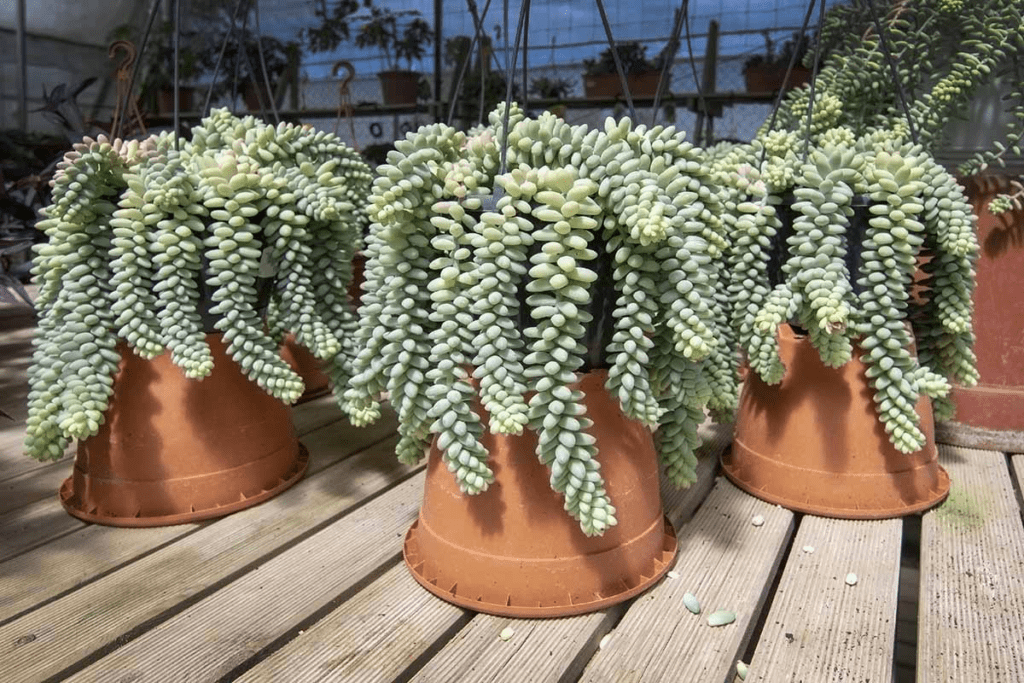How to Grow & Care for Rhipsalis Cereuscula ‘Rice Cactus’ (2024)
Hey folks! Welcome back!
I hope you all are doing appreciable in your gardening field. Today I am here with another amazing plant that is known as Rice Cactus. It is scientifically known as Rhipsalis Cereuscula. It is one of the evergreen plants that are succulent and native to South America.
Rhipsalis Cereuscula needs good maintenance so that they thrive well, so feeding them with a good amount of sunlight, water, humidity level, temperature needs, and many more to see its interesting magical results.
Let’s get started.
| Scientific Name | Rhipsalis cereuscula |
| Common Name | Rice cactus, Coral-cactus, Mistletoe Cactus |
| Light | Bright indirect sunlight |
| Watering | Twice a week or as needed |
| Temperature | 60°F to 75°F (16°C and 24°C) |
| Hardiness Zone | USDA Hardiness Zone 10a to 11b |
| Humidity | 45 – 50% |
| Soil Type | Gritty and rich soil mix |
| Soil pH | Slightly acidic to acidic (5.0 to 6.5). |
| Fertilizing | A balanced fertilizer once every two weeks (during the growing season) |
| Repotting | Every 1 to 3 years |
| Pruning | At least once a year |
| Propagation | Stem cuttings |
| Toxicity | Has mild toxicity |
| Mature Size | 24 inches to 5 feet tall |
| Bloom Time | Year-round at best-growing conditions |
What’s Unique About Rhipsalis Cereuscula?
The rice cactus is one of the plants that is similar to the other succulents but has various features within. It will produce cylindrical stems in the plant and is scientifically known Rhipsalis crepuscular plant.
This plant is famous for its long branches that add elegance to the home garden. it tends to produce white-colored blooms in the plant that are held on the stem.
It is native to the rainforest of Central and South America. You will be happy to know that this variety is widespread all over the world and is famous in every gardener’s home. It is especially distributed in tropical regions of Brazil and Uruguay.
How to Grow Rhipsalis Cereuscula ‘Rice Cactus’?
Though there are various methods of propagating the plant but one of the successful methods is through stem cuttings. Even in my previous articles, I have described the process of growing plants with the help of stem cuttings. So, let’s know how to grow Rhipsalis Cereuscula by using stem cutting:

Step 1- Firstly, you have to keep the collection with you which includes sterilized scissors, stem from the mother plant.
Step 2- Now you have to fill up the pot with vermiculite and mist it with some water for moisture.
Step 3- Put the potting mix in the container and keep the stem in it but avoid touching it with the ground level.
Step 4- Try to keep your plant in a bright room that does not let the full sun come in.
Step 5- Then you will observe roots on the stem after 2 weeks. Consistently water it for about one month.
Step 6– After five weeks you can transplant the plant in a new container with more space than the previous one.
This is how you are done with the process of growing Rhipsalis Cereuscula in your home garden via stem cuttings.
How to care for Rhipsalis Cereuscula ‘Rice Cactus’?
Growing a plant doesn’t include much effort, do you know what the crazy part of it is? It is to take care of that plant and maintain its growth. So, it is important to feed the plant with more nutrients and fulfill its requirements like a supply of water, sunlight, etc which will be discussed below:
- Sunlight
- Soil
- Water
- Fertilizer
- Pruning
- Humidity and Temperature
- Potting and repotting
Let’s know about them in detail:
Sunlight needs
- Rhipsalis Cereuscula tends to grow where they can receive bright sunlight for their growth.
- They tend to grow in the lower canopies where they are being filled with natural sunlight.
- When you grow your plant inside your home, then you have to keep your plant away from the sunny windows so that the plant remains in a humid environment.
- Make sure not to expose your plants to the full sun so that the leaves of the plant get protected.

Watering needs
- Rhipsalis Cereuscula prefers to receive water daily as it has great foliage to grow.
- This plant tends to store water in its leaves, so if you water them less, then they can tolerate that.
- When you grow your plant in yur home garden outdoors, then you have to water your plant 1-2 times a week, especially at the time of spring and summer.
- You have to check the soil’s moisture by inserting a finger in the soil about an inch and if it is dry, then you have to water your plant.
Humidity and Temperature needs
- Rhipsalis Cereuscula plants like to thrive well if you provide them with a temperature range of 70°F to 75°F in the daytime whereas 60°F to 70°F in the nighttime.
- You have to maintain an ideal atmosphere for your plant so that it thrives well especially by not letting them expose to the cold drafts.
- The ideal humidity level for these plants lies between 50 to 55 %.
- If you increase the level of humidity in your room, you have to fill a pebble tray with water and place it under the plant to increase the moisture in the plant.
Soil needs
- The soil needed by these plants is well drained and also a mixture of peat moss or sphagnum moss, and perlite to make it more organic.
- The ideal pH level for these plants is 5.0-6.5 which is slightly acidic.
- So, for this, you have to keep in mind to use a pot with good drainage holes so that the soil remains well drained.
- The organic mixture helps the plant to enhance the texture of the soil and also improves the plant’s growth.
Fertilizer needs
- These plants like to be fertilized at the time when they grow actively during the summertime and spring season.
- The ideal fertilizer ratio for these plants is 10-10-10 or 8-8-8. Making use of a balanced fertilizer would be suitable for the plants.
- Make sure to fertilize your plants after every 2 weeks to enhance their growth.
- Last but not least, it is essential not to overfertilize your plant as it is not good for the plants.

Potting & Repotting
- Rhipsalis Cereuscula likes to be repotted when the plant overgrows and its roots come out from the drainage holes.
- They like to be repotted after every 1-3 years.
- Keep a check on the plants and while repotting, you have to put the fresh soil mix in the new container.
- Make use of a bigger pot with more good drainage holes than the previous one so that the plant feels comfortable there.
Pruning needs
- Rhipsalis Cereuscula does not ask for much pruning as they grow slowly. So, to increase the growth of the plant, you have to prune off the plant.
- When the plants get affected, then you have to cut the leaves so that the foliage does not get damaged.
- Trim out of your plant one time a year to promote new growth in the plant.
Common problems with the Rhipsalis crepuscular
As I mentioned growing and caring for the growth of your plant is not a difficult task but remaining consistent with your plant is somehow a tricky task to do. you have to maintain the growth of the plant so that there are no problems that the plant will face in the future.
So as your plant has faced such problems, you need to know about those common problems with your plant and find the solutions for it. They are as follows:
- Pests
- Diseases
- Growing problems
Let’s get started to learn about such problems in more detail:
Pests
One of the problems that is faced with rice. Cactus plant is the attack of pests on the plant. But why? Do they like the plant or are they coming to a plant to satisfy their hunger? You need to know about these questions and find solutions for a healthy plant.
You will observe the pests on the plant when you observe that there are white spots on the plant leaves. The tissues of the plant become dead when the insects infect the plant such as spider mites, aphids, white flies, and many more.
So, you have to remove them by making use of horticultural oil like neem oil or you can even make use of a water spray on the plants
Diseases
What kind of diseases will attack the rice cactus plant? Diseases tend to attack the plant and it becomes important for you to protect your plant from those diseases at the earliest stage. You can save your plant by pruning the plant and spraying the plant with water.
Diseases like powdery, mild, or fungal infections will affect the roots of the plant which will not let the plant grow at its best. So you have to trim it off so that all the dead and decayed leaves from the plant get removed.
Growing Problems
Some of the growing problems of the rice cactus have contributed a lot to the caring routine of the Gardner. It includes over watering of the plant, underwatering the plant, and providing them with insufficient temperature or lack of humidity in the plant.
All these factors indicate the growing problems of a plant. This is because overwatering will make the plant spoil by causing fungal infections, and nutrient deficiency.
So it is important to prevent such growing problems by using the correct techniques for your plant. So you have to provide sufficient water to the plant, feed the plant on time, and trim the plant.
Wrapping up the context
In this guide, you come to know about the Rhipsalis Cereuscula ‘Rice Cactus’. The rice cactus is one of the plants that is similar to the other succulents but has various features within. It will produce cylindrical stems in the plant and is scientifically known Rhipsalis crepuscular plant.
This plant is famous for its long branches that add elegance to the home garden. it tends to produce white-colored blooms in the plant that are held on the stem.
I hope you are clear with the process of growing Rhipsalis Cereuscula ‘Rice Cactus’ in your home garden as it is the easiest to grow. If not, then also you can read the whole guide to understand it properly. Till then safe gardening.
Thanks for reading! Happy gardening!


